Wildlife Removal Blog 2008
This weblog chronicles some of the adventures I have had while operating my wildlife removal company in Orlando, FL - Click any of the photos for a larger image and more information.
I currently have 351 blog entries. You can select them sorted as such:
2003 •
2004 •
2005 •
2006 •
2007 •
2008 •
Armadillo •
Bat •
Bird •
Dead •
Opossum •
Rat •
Snake •
Squirrel •
Others •
Repairs •
All Entries
11.09.2008 - How to Tell if Snake is Venomous / Poisonous
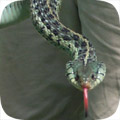 |
|
| The above photo is of a harmless garter snake - yet many people see this snake and assume that it's dangerous. Very few people seem to be able to properly distinguish a venomous snake from a harmless one. As a wildlife removal specialist, I'm
privy to the wildlife opinions of many people. I hear, on a daily basis, just what people think of the wild creatures all around us. It seems that no single type of animal is more misunderstood than snakes. The primary misconception is that snakes are dangerous and must be feared.
In addition, snakes are constantly ...click for more |
10.03.2008 - Mother Raccoon with Babies
 |
|
| Raccoons are excellent mothers. They take great care of their babies. When the babies are young, they stay in a nest while the mother raccoon goes
and forages for extra food to make enough milk to feed them. After about twelve weeks, the young have grown large enough that they start to follow the mother outside of
the nest area (the nest is usually in a tree hollow or an attic) and outside, where they learn from her how to forage for food, and where are the best places to go. They
are weaned by 16 weeks. The young stay with her for some time, up to nine months, and ...click for more |
09.18.2008 - Red Touch Yellow, Kills a Fellow. Red Touch Black, Friend of Jack
 |
|
| Many people have heard this rhyme for snake identification, even though very few people will ever encounter any of the snake species involved. For some reason, it's simply a popular rhyme, and people
seem to remember the idea that there's some rhymey phrase out there to help distinguish between venomous snakes and safe ones. The snakes in question are the venomous Coral Snake,
and a number of copycats, such as the Scarlet King Snake and the Florida Scarlet Snake. Oftentimes in nature, a species will mimic the appearance of a dangerous spe
...click for more |
09.09.2008 - Big Brown Bat Photograph
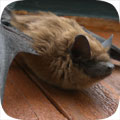 |
|
| This is a detail photograph of a Big Brown Bat (Eptesicus fuscus). The Big Brown is a common bat involved in nuisance wildlife removal, because like
the Little Brown Bat, it's a colonizing mammal that likes to live in buildings. It looks fairly similar to the Little Brown Bat, except it's ...bigger. It has a
wingspan of maybe 10 inches and it weighs 5/8 oz, which while small, is quite a bit larger than your average colonizing bat. I don't deal with Big Brown Bats here in
Florida. I deal with the Freetails and the Evening Bats. The Big Brown is more common up north. This photo ...click for more |
08.14.2008 - Mole Extermination
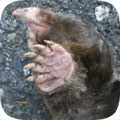 |
|
| This is a nice photo of a Townsend's Mole, taken in the Seattle area by my friend Sean. He traps and removes moles. I don't really do any mole
extermination here in Florida. It's not worth my time, and frankly, I just never got good at it. Mole control is difficult. Even for me, who did it for a
while in Pennsylvania and experimented in Florida. Unfortunately, there is no quick and easy way to exterminate moles. Many people want to buy poison to kill
moles. The problem is that moles eat only live food - almost entirely earthworms, and they won't eat anything inanimate, ...click for more |
07.27.2007 - Raccoon Hunting
 |
|
| Ha ha HAA!!! I've got the little sucker now! I'm going to blast it with my .22 rifle, let the dogs get at it, skin it, tan the hide, make raccoon stew, and pick my teeth with the bones! Rar! That raccoon doesn't stand a chance against my superior
manly intellect and my super manly weapon that I carry with me. I can't wait to take my rambo knife to this sucker's throat! No way you could outrun my trusty pack of hound dogs, you sneaky little raccoon. You thought you could get away from me, but now it's lights out!
The final curtain for you! I see you trying to hide up in that tree, you ...click for more |
07.15.2008 - Male Bat Roosting in Tree
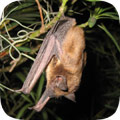 |
|
| Whenever I remove bats from a home or building, I inform the person with the problem that their bats are all female bats, known as a maternity colony. When bats gather in a large group, it's for the purpose
of forming a safe haven to give birth to and raise young bats. The exact time of birth and weaning depends on species and latitude, but in North America, it's always in the summer. Female bats only give birth once per
year, and again depending on species, often to only one pup. After I tell the person this, I hear the inevitable follow-up, "where do the males go?"...click for more |
07.14.2008 - Eastern Diamondback Rattlesnake
 |
|
| This is an Eastern Diamondback Rattlesnake that I caught. It's a good sized specimen. This snake lives throughout most of the
state of Florida, but it's pretty rare in the Orlando area. It's rare in most developed areas, because it's a slow snake and it stands its ground, and people have a habit of
killing them off. It's true that the bite of this snake is very dangerous - many herpetologists think it's one of the 10 deadliest snakes in the world - but it won't strike
unless provoked. Nevertheless, most people don't like to have them around, so where there's people, there's ...click for more |
07.02.2008 - Cute Baby Wildlife
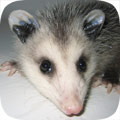 |
|
| Although I specialize in wildlife removal, I also like to take photographs of the critters from time to time. I really enjoy the baby wildlife. Kind of like how most people enjoy puppies and kittens. It's hard not to like these cute little guys.
Many people think that the adult opossum is an ugly animal. However, the baby is downright adorable. Just look at those little hands, that pink nose, those little
ears and those big brown eyes! I could just eat this little fellow right up! I also like the blue patches in the ears. It's generally accepted that all
animals have a paternal response to juven ...click for more |
06.19.2008 - Raccoons In Garbage Can
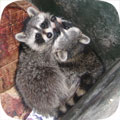 |
|
| Raccoons are very urbanized animals. Studies reveal that raccoon population densities are about ten times as high in urban areas than in wild areas.
Cities and suburbs simply have more of the resources needed for raccoons to survive - shelter in our attics and under our buildings, and food from pet dishes, handouts, and of
course dumpsters and trash cans. I frequently get calls about raccoons that are causing problems around dumpsters and garbage cans. Raccoons are very strong and
crafty, and they make a big mess. They love to tip over garbage ...click for more |
06.03.2008 - Raccoon Holes Leading Into Attic
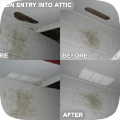 |
|
| Here are a couple of classic raccoon entry points. This house has wooden soffits. Oftentimes, homes such as these have vent holes in the soffits.
These vent holes are a standard size and shape, about a food long by four inches wide, with round ends. This hole may not look very large, but animals can squeeze through
very small areas. While it's easy to imagine a rat or squirrel running through these types of holes - and they do - a full sized raccoon can also easily slide through
these openings. Yes, a big fat raccoon. In the above photos you can see a lot of muddy foot ...click for more |
05.15.2008 - How to Prevent Rodent Damage in an Attic
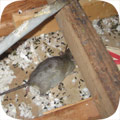 |
|
| Rodents that live in attics cause more problems than just annoying noise. They also cause a number of different types of damage inside an attic, some of
which are serious. Look at the above photo, and you will see several types of rodent damage in this customer's attic. Rat Droppings - Rats have high
metabolisms, and they leave many droppings, often thousands, in an attic where they live. These droppings may or may not smell bad, but they are unsightly and they do
carry disease that people can contract if they come into contact with the droppings. Rat Urine ...click for more |
04.20.2008 - Pigeons in the Attic - Get Them Out
 |
|
| Pigeons thrive in urban areas. They are one of the few animals that thrives with people in general.
They like to live on buildings, and they like to live in buildings, and this means that they like to live in the attics of homes when they can get access.
I deal with many cases of pigeons in attics each year. The first step is to remove all of the pigeons. I accomplish this via a number of tactics, from
the use of one-way exclusion devices to physical removal. The second step is to seal off all of the entry points so that no more pigeons can enter the
building again. The third ...click for more |
04.14.2008 - Types of Florida Water Snakes
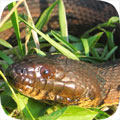 |
|
| Several species of water snake slither and swim their way through Florida's lakes and swamps. The most feared is the venomous
Cottonmouth, or Water Moccasin, as some call it. While these snakes are in fact common in some areas, and while you certainly don't want to be bitten by such a snake, most of
the water snakes in Florida are in fact harmless. The above photo is of a Brown Water Snake that I caught. This snake poses no danger. It's not poisonous, and is usually
docile. Any snake can strike if provoked, but most would much rather just swim away in ...click for more |
04.14.2008 - Playing Possum
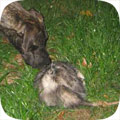 |
|
| Everyone has heard about "playing possum". It's a defense mechanism of the North American Opossum. If it's attacked by a predator, sometimes it completely passes out, and appears dead. It is the instinct of many predatory animals to shake and kill a
critter that is moving or fighting back, but they often leave dead animals alone. Thus, if attacked, by feigning death, the opossum doesn't receive any further attack. With luck, the attacking animal loses interest and leaves. The opossum wakes up after 15 minutes or so, and
walks away. As far as I know, this defensive tac ...click for more |
04.11.2008 - Dead Animal Carcass Removal Under House
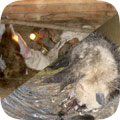 |
|
| I am the best. The best there ever was or ever will be. At removing dead animals from homes. That's it though, I'm not the best at anything else. This here job wurn't too
tough, but it were tough enough that neither the homeowner or the first company they called couldn't git er done. I got her done in one minute, forty two seconds. The house smelled horrible. I stepped inside and I knew it
was a dead opossum. Dead possums smell different from dead rats, cats, bats, or shower mats. My nose led me right to the air vents - a rare source for the odor, but I could tell. I could ...click for more |
04.08.2008 - Raccoons Tearing Up Sod
 |
|
| Here's a common problem that people have with raccoons - the destruction of sod. If you have your yard re-sodded, watch out for raccoon problems!
Raccoons are very clever, and they have nimble hands. When yards are sodded, it's common for tasty earthworms and grubs to live right under the sod, on the surface of the
soil. For some reason, raccoons always have a tendency to know that there's food to be had, and they just peel back the surface of the sod like a rug, and eat the tasty
morsels underneath. I was called out to trap a troublesome raccoon that was ...click for more |
03.29.2008 - Mole Poison
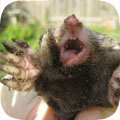 |
|
| "Blargh!", said the above mole as it gasped its last breath before dying. This mole was murdered. But how? BY POISON! Yes, mole poison
killed this mole. I know, because I poisoned it myself. I invited this mole to a fancy dinner, but little did he know that I placed cyanide in his wine. Just
a few sips, and he keeled over as I cackled with laughter. This mole will dig up my yard no more. Of course the above story is fictitious. I actually used
iocane powder. Okay, I didn't use poison at all. There is no such thing as an effective mole poison. I say effective, ...click for more |
03.15.2008 - Mouse in Attic - Trapping & Removal
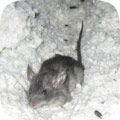 |
|
| Here is a rare photo of a mouse in an attic. If you want to solve a problem with a mouse in the attic, you have to follow the steps I've outlined many times on
this site. Step one, inspect the entire house, top to bottom, identify the areas of mouse use in the attic, and find any possible entry holes that lead into the house.
Step two, seal the entire house shut, with steel repairs. Step three set a dozen or more mouse traps on the prime locations in the attic. Step four, remove trapped
mice and reset traps until no more are caught. Step five, clean and decontaminate the attic. ...click for more |
03.13.2008 - Flying Bat Photograph
 |
|
| Here is my best photograph of a bat in flight. I took this picture inside a customer's home. A bat had gotten inside the house, and was flying around and around. She hid in the kitchen as this bat circled the living room. I could have quickly netted the
bat, but I wanted to try to capture a good photo first. Bats tend to fly in repeated patterns. Even when they are outside and about the re-enter their home (your home, I should say), they swoop repeatedly in a patterned loop. This bat was doing the same thing. Thus, I knew
exactly where and when the bat would zoom by. On ...click for more |
02.10.2008 - Can Snakes Climb? Snake Crawls up a Wall
 |
|
| Many people ask me about the climbing capability of snakes. In particular, people want to know if snakes can get up into their attic. The answer is that
yes, some species of snake are excellent climbers, and can climb walls. But not just any wall. The snake must have something to grab ahold of and push off of. Not
even a rough surface will do - snakes can't "stick" to walls the way insects, rats, and lizards often do. The only times I've seen snakes climb walls are brick walls. I've
seen this a few times. The gaps where the brick meets the soffit also provide entry ...click for more |
02.08.2008 - Squirrel Nest in Attic
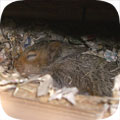 |
|
| Here are two separate photos of squirrel nests in the edges of attics. Squirrels most commonly make their nest at the edge, often down in the eave, or
soffit. Squirrels are less likely to run all through the entire attic the way rats do. They often just stick to the edges. Female squirrels have two litters
of baby squirrels per year. The first litter is in late winter, often in January or February. The second litter is in late summer, usually in August. Mother
squirrels seek out a high place in which to make a nest, safe from predators. Baby squirrels are very vulnerable. Sometimes ...click for more |
02.02.2008 - Ladder Work on Apartments
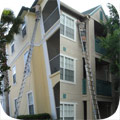 |
|
| Most of my jobs involve ladder work. Except for cases of ground trapping, most cases of wildlife removal involve animals that have invaded homes or
buildings, usually the attics, and I need to address the problems high up, where the animals get in. This calls for ladder work. I carry three standard ladders on
my truck. One is just a 6' stepladder, which I mostly use to enter ceiling attic hatches inside homes. I also use it for work repairing under eaves of single story
homes, and other home repairs for which I only need a few extra feet of height. The second ladder is ...click for more |
01.25.2008 - Raccoons in House - Get them Out
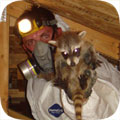 |
|
| People always ask me how to get raccoons out of the house. Raccoons are common nuisance critters in neighborhoods, and they often break into houses.
They have very little fear of people, and just want a nice place to live. Unfortunately, they can cause quite a bit of damage, in addition to noise. I've seen
raccoons in many areas of homes. They most commonly break in somewhere on the roof and live in the attic. I've also seen them live in eaves, inside wall cavities,
down in chimneys, and other parts of the architecture. Sometimes they even go into the ...click for more |
01.25.2008 - Pigeon Trap to Get Pigeons Out of a House
 |
|
| Pigeons are opportunistic animals. Like any animal, they need shelter, and the females seek out a safe place in which to raise young. Just
as is the case with raccoons, squirrels, rats, and other animals, pigeons have found that the attics of homes make an ideal place to live - they're safe from
the weather, dry, warm, and safe from predators. Thus, pigeons love to live in the attics of homes when possible. They need a certain amount of room in order
to enter and exit. In this case, it's a classic scenario. This house has a barrel tile roof, one of the eaves, ...click for more |
01.05.2008 - Norway Rat Control & Trapping
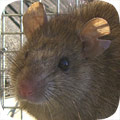 |
|
| Here is a photo of a Norway Rat (rattus norvegicus) trapped in a cage trap. I usually deal with Roof Rats in Florida. This photo was sent to me by my brother-in-law Sean, who operates his own wildlife removal business in Seattle, WA. He deals with more with
Norway Rats up there. Thought I trained him on Roof Rats down here in Orlando, most of the same principles and techniques apply to both rat species. These rats are by far the dominant rat species in the world, and both occupy a certain ecological niche and thrive as nuisance rodent
species worldwide. I will now exa ...click for more |
|


